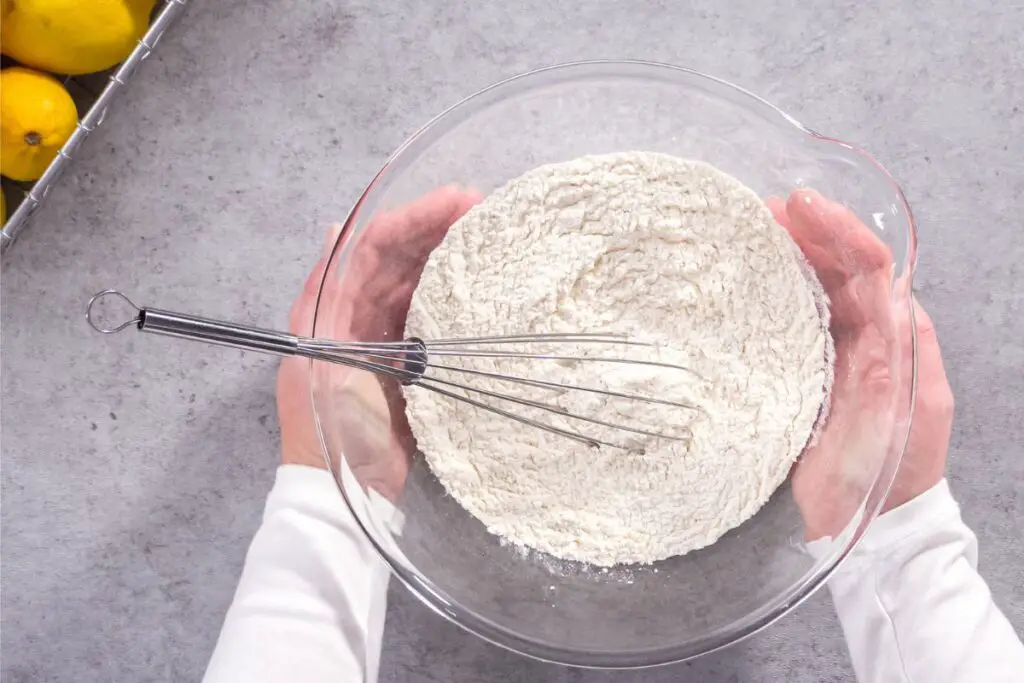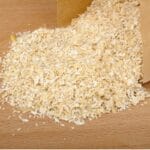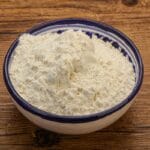In a nutshell, the best replacements for self-rising flour are all-purpose flour, whole wheat flour, oat flour, gluten-free flour blends, etc. Choose the right option based on your dietary needs and the recipe.
Self-rising flour is a staple in many kitchens. Since it already contains baking powder and salt it makes baking simple with fewer ingredients and less prep time.
Although it’s not recommended when making yeast bread, it can be used in cakes, pancakes, cookies, waffles, muffins, and loads of other baking recipes.
If your recipe calls for self-rising flour and this is not something you generally keep in the pantry, don’t give up on your baking plans just yet. There are plenty of alternatives you can use to substitute self-rising flour, including making your own.
In this guide, we’ll help you choose the best option according to your dietary needs, allergies, and the recipe you’re making. Let’s dig in.
How To Prepare Homemade Self-Rising Flour
The one differentiating factor between self-raising and plain flour is that it already includes a leavening agent. Regardless of the self rising flour substitute you choose, you will need to add a raising agent.
The leavening agent will set off a release of gas or air during baking or heating which causes the dough to rise. Gluten is the component in wheat and other gluten grains that makes the dough stretchy. When the gas is released the air bubbles form pockets that hold their shape and set to become light and fluffy tender baked goods.
Gluten-free flours lack this stretchy quality which doesn’t allow the baked goods to rise in the same way. Gluten-free baked items usually require a blend of different flours and additional ingredients to achieve the same lightness.
You can use any of the below options as a raising agent when substituting self-rising flour.
Baking Powder
Add two teaspoons of baking powder for every three cups of flour.
Baking Soda and Cream of Tartar
To make your own baking powder you can mix ¼ teaspoon (1 g) baking soda (bicarbonate of soda) with half a teaspoon (1.5 g) cream of tartar. Use this to replace one teaspoon of baking powder.
Baking Soda and Buttermilk
To replace one teaspoon of baking powder, mix ¼ teaspoon (1 g) of baking soda with ½ a cup of buttermilk. You can use yogurt or sour milk if you don’t have buttermilk. If you go for this option, reduce liquids elsewhere in your recipe by ½ cup to prevent the batter from becoming too runny.
Baking Soda and Vinegar
Another option is to combine ¼ teaspoon (1 g) baking soda with ½ a teaspoon (2.5 g) of vinegar or lemon juice to replace one teaspoon of baking powder.
Baking Soda and Molasses
Baking soda will also react with honey or molasses to create a leavening effect. To equal one teaspoon of baking powder, combine ¼ teaspoon (1 g) of baking soda with ⅓ cup (112 g) of molasses or honey.
Keep in mind that the extra moisture and sweetness will affect the flavor and consistency of the dough. You may need to make adjustments by reducing the sugar content elsewhere and possibly using a little less liquid to prevent the batter from becoming too runny.
Choose any of the above leavening agents and add them to the alternative flour below to make your substitute. Make sure all the ingredients are evenly distributed when you make your own self-rising flour.
Best Self Rising Flour Substitutes
#1. All-Purpose Flour
All-purpose flour or cake flour combined with baking powder and a pinch of kosher salt is the simplest way to replace self-rising flour in any of your favorite recipes. Replace the baking flour in equal quantities and add your leavening agent accordingly.
This is a good self rising flour replacement for making biscuits as well as any other recipe that requires a replacement, however, it is not gluten or wheat-free.
#2. Whole Wheat Flour
Whole wheat flour is less processed than regular flour since it still contains the bran. One thing to keep in mind with the whole wheat option is that it is heavier, so may not be ideal for light baked items like cupcakes and light pastries. It is, however, perfect for muffins and bread.
Related: Wheat flour replacement
#3. Oat Flour
This is a whole grain alternative that can either be purchased ready ground or made at home by pulsing dried oats into a powder. Although it is wheat-free, not all oats are necessarily gluten-free. There are some certified gluten-free options available.
This option requires additional leavening to achieve a good rise. For every one cup of oat flour add 2 ½ teaspoons of baking powder or an alternative option from the list of raising agents above.
#4. Alternative Blends
Using a gluten-free flour blend is the best option if you need a gluten-free alternative. These blends contain a mix of flours in ideal proportions for the best texture, flavor, and baking results. Replace this in equal quantities and add your chosen leavening agent.
#5. Spelt Flour
Spelt is a form of wheat so won’t be suitable for people with a wheat or gluten allergy. As with regular wheat flour, it comes in a refined and whole-grain form.
Although you can substitute spelt measure for measure by adding a raising agent, you may need to adjust the quantity of liquid slightly since it is more water-soluble than wheat.
#6. Amaranth Flour
Although technically not a grain, amaranth is a gluten-free replacement boasting great nutritional quality and slightly higher protein content.
Since it is somewhat denser, it is best used for pancakes and quick bread and is best combined in a 1:1 ratio with a lighter flour for the best results. Don’t forget your leavening agent.
#7. Almond Meal
Almond or other nut flours are gluten-free and simply made by grinding raw nuts into a powder form. They are high in protein, fiber, and healthy fats, but are also denser than grains.
For the best results, combine it with other types of flour and a raising agent, or use a recipe that contains whipped eggs to incorporate air. This is a great option for cookies, pie crusts, muffins, and bread.
Due to the higher fat content, it is best to store nut meals in the refrigerator or freezer in an airtight container.
Related: What can I substitute for almond flour?
#8. Quinoa Flour
Like amaranth, quinoa has great nutritional value and is best used combined with other flours, moist ingredients, and a raising agent. Some recipes may call for additional ingredients such as xanthan gum to improve the texture further. It has a nutty taste and works well in muffins and quick bread.
FAQs
Conclusion
There are a number of options to easily substitute self-rising flour if needed. Whether you want to improve the nutritional quality of your baked goods or need to cater to allergies, there’s a suitable substitute for you.
When using gluten-free grains, make sure they are combined in the right quantities to avoid having a very dense or chewy end product, and always remember to add your leavening agent to ensure a fluffy texture and good rise. Happy baking!
*image by urban_light/depositphotos









